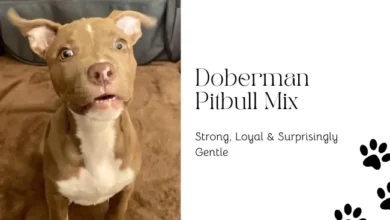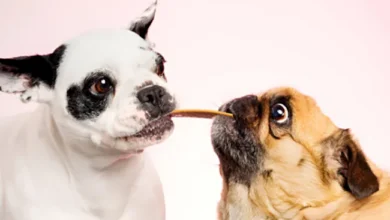Everything You Need to Know About the Great Dane Pitbull Mix: Facts, Characteristics, and More
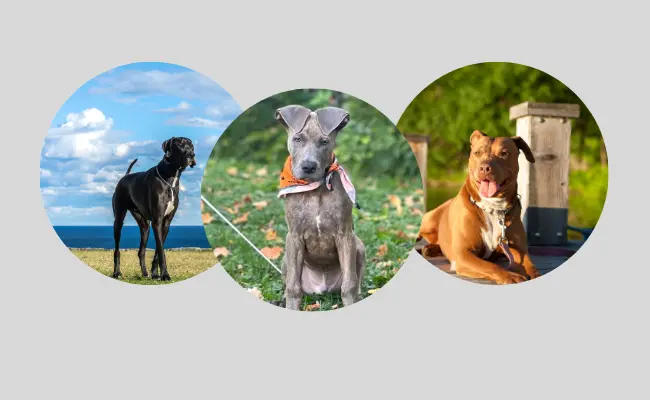
MixbreedDogs.com is an Amazon Associate, and we earn from qualifying purchases.
The Great Dane Pitbull Mix, often called the Great Danebull, combines the best qualities of both parent breeds. This hybrid breed blends the Pit Bull’s energy, health, and affection with the Great Dane’s friendly, patient, and majestic demeanor. These dogs are not only lovable but also large to giant in size, making them ideal for families who enjoy playtime and bonding with their furry companions.
Characterized by their gentle, loving, and affectionate nature, Great Dane Pitbull Mixes thrive in households where they receive plenty of attention and care. They have a strong need for companionship and may experience separation anxiety if left alone for extended periods.
One of their standout features is their compatibility with children and other dogs, thanks to their friendly disposition. Their high energy levels necessitate early training to ensure proper behavior. Fortunately, they are intelligent and eager to please, making training relatively straightforward when approached consistently and firmly.
Regrettably, many of these wonderful dogs end up in shelters or rescue organizations. Choosing to adopt a puppy rather than purchasing one from a breeder can not only save you money but also save a life, contributing to the welfare of these deserving animals.
Great Dane Pitbull Mix Overview
| Weight | 60-100 pounds |
| Height | 24-30 inches |
| Lifespan | 10-15 years |
| Temperament | Gentle, affectionate, protective, sweet, friendly, intelligent, playful |
| Suitable for | Families, active individuals, multi-pet homes, large homes, fenced yard |
| Colors | Black, white, blue, fawn, red, brown, sable, and brindle, or a combination of the colors |
Breed History & Parent Breeds
The historical background of the Great Danebull might be somewhat elusive, as it often is with mixed breed dogs. To gain insight into its origins, let’s delve into the histories of its parent breeds, beginning with the Great Dane.
Great Danes
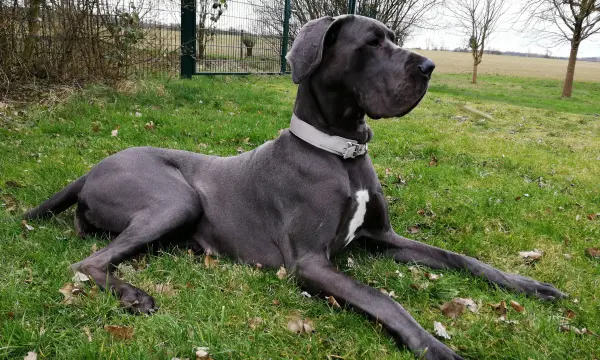
The lineage of Great Danes can be traced back to ancient times, with depictions of dogs resembling them appearing on Egyptian artifacts. These early dogs likely found their way to other corners of the world through trade with Assyrians, who exchanged them with Greece and Italy.
Upon reaching Germany, their role shifted towards hunting wild boar. In fact, they were initially known as “Boar Hounds” to reflect this function. However, around the 1600s, their role transformed, and they became dogs associated with the nobility in Germany. The finest-looking dogs were chosen to reside within the nobles’ homes, leading to their name change to “chamber dogs.”
It wasn’t until the 1700s, after a Frenchman visited Denmark and encountered this new breed, that they were dubbed “Great Dane.” Interestingly, the name stuck despite the breed’s lack of Danish origins. In 1880, German officials held a vote, resulting in the name “Deutsche Dogge,” meaning German Dog, but it didn’t gain traction in English-speaking countries.
Throughout the 18th Century, Great Danes maintained their status as prestigious dogs, guarding carriages and estates. The shift from boar hunting to companionship with nobles led to their development as a gentle and affectionate breed. The American Kennel Society officially recognized the Great Dane as a breed in 1887, making it the 34th recognized breed. Today, they rank as the 16th most popular breed.
Pitbull
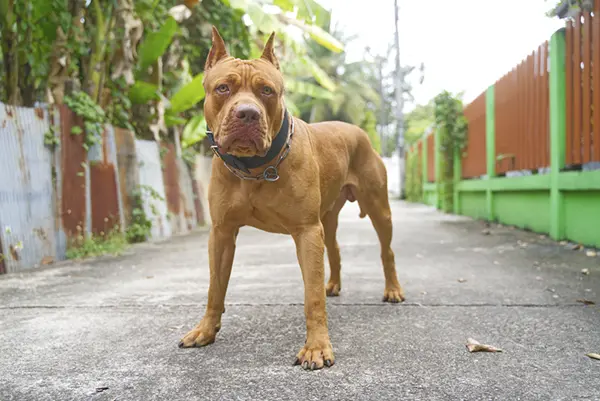
Pitbulls have their origins in Old English Bulldogs, which were originally bred for the cruel sport of “bull baiting.” This gruesome entertainment involved dogs chasing bulls for hours until the bull collapsed from exhaustion. The British Parliament outlawed this practice in 1835, leading to a shift toward “ratting,” where dogs were pitted against rats in pits, hence the name “Pitbull.”
Over time, the public’s interest in ratting waned, and the focus shifted to dogfighting, marking the beginning of a dark chapter in the breed’s history. Despite their use in fighting, Pitbulls were selectively bred to be affectionate and gentle with humans, a trait they still possess today.
Pitbulls arrived in the United States shortly before the Civil War when immigrants from the British Isles brought them. Life in America was kinder to the breed, and they found various roles, including herding cattle and sheep, guarding livestock and families from wildlife and thieves, and assisting in hunts. Their loyalty and affection toward their owners soon established them as beloved family companions.
During World War I and World War II, Pitbulls were featured in numerous advertisements as the national mascot. They also played a crucial role as the first war dog employed by the United States. Despite their popularity and rich history in the country, the American Kennel Club does not officially recognize them as a breed. Nevertheless, the United Kennel Club and the American Dog Breeders Association do acknowledge this remarkable breed.
The Great Danebull: Great Dane Pitbull Mix
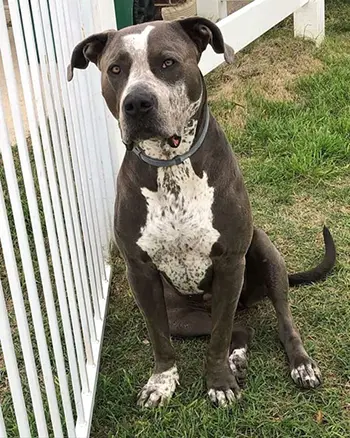
As previously mentioned, the Great Danebull is a unique hybrid breed resulting from the combination of the Great Dane and the Pitbull. This intriguing mix blends the imposing size and muscular build of the Great Dane with the endearing facial features of the Pit Bull, particularly their charming floppy ears. However, as is often the case with hybrids, there can be considerable variation in their physical appearance.
Read More: Pomeranian Pitbull Mix
Size & Appearance
The Great Dane Pitbull Mix falls into the category of large to giant-sized dogs. They typically weigh between 60 to 100 pounds and stand proudly at heights ranging from 24 to 30 inches. Their long, slender physique leans more towards the Great Dane, featuring long legs and large paws.
In terms of their distinctive features, their ears are usually short, square-shaped, and dangle loosely, bearing a closer resemblance to the Pitbull than the Great Dane. Their coat color varies but often reflects a blend based on the coloring of their parents. Common coat colors include white, black, fawn, blue, brown, red, brindle, sable, or a combination of these hues. Their lengthy tail typically exhibits a gentle upward curl.
The Great Dane Pitbull mix boasts a short, glossy, smooth, and firm coat. While their coat provides some insulation, extra care is necessary during colder months, which might involve outfitting your furry companion with a coat. These dogs tend to tolerate warm weather better but may struggle in extreme heat.
Temperament of the Great Dane Pitbull Mix
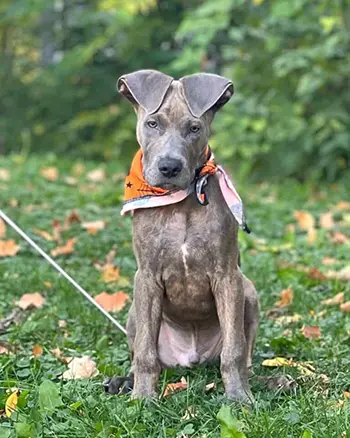
Given the inherently people-pleasing nature of both Great Danes and Pitbulls, it’s no surprise that this hybrid breed is exceptionally affectionate. They are characterized by playfulness, loyalty, and a deep capacity for love, making them an excellent choice for families.
These dogs are typically great with children, but it’s crucial to educate your child on how to interact with their new canine friend. Like most dogs, they may react negatively to hair pulling or rough handling. Due to their size and playful disposition, it’s advisable to supervise playtime to prevent unintentional knocks or tumbles.
The Great Dane Pitbull mix finds their utmost happiness in snuggling with their family, often believing they are lap dogs despite their substantial size. They relish outdoor activities, especially running and playing alongside their owners to expend their boundless energy. Thanks to their outgoing nature, proper socialization at a young age ensures they are friendly around both people and other animals.
These dogs are true attention-seekers and thrive on companionship, which can lead to severe separation anxiety when left alone. This anxiety may manifest in behaviors like excessive barking, chewing, or digging.
Their high intelligence and eagerness to please make them generally easy to train, especially when using positive reinforcement. Keep in mind that, due to the hybrid nature of this breed, temperament can vary from one puppy to another. Observing the parents and other offspring is often the best way to gauge a puppy’s personality.
Advantages of the Great Dane and Pitbull Mix
- Best of Both Worlds: This crossbreed combines the friendliness and size of the Great Dane with the loyalty and protective instincts of the Pit Bull, resulting in a dog that amplifies the positive traits of both parent breeds while mitigating some of the negatives.
- Health: Great Danebulls often enjoy better health compared to pure Great Danes, which can be prone to certain breed-specific health issues.
- Watchdog Tendencies: Combining the Pit Bull’s natural aggressiveness with the Great Dane’s keen hunting instincts, they become highly alert and vocal watchdogs, making them excellent at protecting their surroundings.
- Friendliness Toward Other Dogs: Despite their lineage from a dog-fighting background, Great Danebulls retain the gentle nature of Great Danes and tend to get along well with other dogs, although they may have some of the Pit Bull’s energetic tendencies.
- Affectionate: Despite their larger size, Great Danebulls inherit the affectionate and cuddly nature of their Pitbull ancestors. They often think of themselves as lapdogs and offer plenty of unconditional love and physical affection.
- Low Grooming Requirements: Similar to Pitbulls, Great Danebulls have minimal grooming needs. Their short coats are easy to maintain, and while they do shed, it’s not excessively heavy compared to some other breeds or hybrids.
- Ease of Training: Thanks to their intelligence and the combination of friendly and loyal traits, Great Danebulls are generally easy to train and respond well to positive reinforcement.
Disadvantages of the Great Dane and Pitbull Mix
- General Hybrid Disadvantages: While many people find “best of both worlds” breeds appealing, some may prefer the distinct characteristics of purebred Pitbulls or Great Danes. It’s important to research both breeds thoroughly to determine if the mix suits your preferences and lifestyle.
- Exercise Requirement: These dogs are highly active and require substantial daily exercise. If their exercise needs aren’t met, they may become restless or unhealthy.
- Short Life Span: Being a large breed, Great Danebulls typically have a shorter lifespan, often not exceeding 12 years, even if they enjoy good health like their Pit Bull parent.
- Separation Anxiety: Great Danebulls tend to form strong attachments to their owners and may suffer from separation anxiety when left alone for extended periods. This can manifest as vocalization or destructive behavior in the home.
- Size Issues: While their affectionate nature is a plus, their large size, combined with their perception of themselves as smaller dogs, can lead to problems if they jump on frail individuals or small children. Caution is necessary in such situations.
Exercise Needs & Living Requirements
When contemplating the adoption of a Great Dane Pitbull mix, it’s crucial to recognize their substantial exercise needs and living requirements. This large breed possesses abundant energy and demands ample space for physical activity. Ideal for families with spacious backyards, they are less suitable for apartment living. However, apartment dwellers can accommodate them if they commit to providing extensive daily exercise to burn off their energy.
- Space Requirements: Great Dane Pitbull mixes require a sizable area to run and play, making a large backyard an advantage.
- Daily Exercise: On average, these dogs need approximately one to one and a half hours of exercise per day, which can be achieved through walks, runs, or engaging play in the backyard.
- Playful Nature: They are exceptionally playful and enjoy activities like catch, tug-of-war, and obstacle courses. When selecting toys, opt for sturdy ones capable of withstanding their strong jaws.
Great Danebull Training
Intelligent and eager to please, Great Dane Pitbull mixes are relatively easy to train. However, consistent and firm training is essential to earn their respect and trust.
- Firm Consistency: Maintaining firm and consistent training methods is vital to prevent confusion in the dog’s understanding of commands.
- Positive Reinforcement: Due to their affectionate nature, positive reinforcement techniques work best during training, promoting a more enjoyable and productive learning experience.
- Early Training: Puppies should start training and socialization at a young age to instill proper manners and harness their energy effectively.
- Patience with Adults: If adopting an untrained adult mix, be prepared for a potentially more challenging training process, as they may be set in their ways. Patience is key in such cases.
Great Danebull Health
While generally healthy, Great Dane Pitbull mixes can inherit health issues from their parent breeds. To mitigate these risks, obtaining the medical records of the parents is advisable.
- Hip Dysplasia: A genetic condition that affects the hip joint, causing pain and potential mobility issues. Regular vet check-ups can help monitor and manage this condition.
- Cardiomyopathy: A heart disease more common in Great Danes, characterized by irregular heartbeats. Medication can control it and allow for a full life.
- Bloat (Gastric Dilatation Volvulus): A severe condition that requires immediate treatment, causing the stomach to twist and cut off blood supply. It can be fatal if not addressed promptly.
- Cancer: This breed is prone to various types of cancer, particularly bone cancer. Early detection is crucial for successful treatment.
Great Danebull Nutrition
These large dogs have hearty appetites and require between 3 to 6 cups of food per day, which can amount to a monthly cost of around $55 or more.
High-Quality Diet: Opt for high-quality dry dog food designed for large breeds, free from artificial ingredients or fillers.
Supplements: Provide daily fish oil or glucosamine supplements to support their joint health.
Recommended Dog Food: Choose a food that’s rich in protein and of high quality, free from artificial ingredients or fillers. Here are some options to consider:
- The Farmer’s Dog fresh, human-grade recipes
- American Journey Salmon & Sweet Potato Recipe Grain-Free Dry
- Taste of the Wild High Prairie Grain-Free Dry
Since this breed may be prone to bloat, which can result from eating too quickly, consider using a slow feeder. This not only helps prevent bloat but also provides mental stimulation for your pup. It’s a two-in-one solution!
Grooming
Grooming a Great Dane Pitbull mix is relatively straightforward, but they are heavy shedders, necessitating regular cleaning to manage the shedding.
- Daily Brushing: Their short hair makes daily brushing easy. Avoid excessive bathing to preserve natural oil production, bathing only when necessary.
- Ear Cleaning: Check and clean their ears at least once a week.
- Nail Trimming: Occasional nail trims may be necessary, which can be done by a professional groomer if needed.
- Dental Care: Brush their teeth at least every three days to ensure dental health.
Here are the tools you’ll need:
Great Danebull Breeders & Puppy Costs
When seeking a Great Dane Pitbull mix, consider both breeders and adoption options.
- Breeder Selection: If opting for a breeder, ensure they are reputable and provide the health history and temperament of the parents.
- Cost: Expect to spend approximately $600 to $1,000 from a breeder for a puppy.
Great Danebull Rescues & Shelters
Exploring rescue organizations and shelters is an excellent way to find a Great Dane Pitbull mix while potentially saving a dog’s life.
- Rescue Organizations: Look into organizations like Rescue Me or Pitbull Rescue Central, which specialize in these breeds.
- Adoption Costs: Adoption costs from rescue organizations or shelters are generally more affordable than purchasing from a breeder.
Great Danebull As Family Pets
Great Dane Pitbull mixes make wonderful family pets, characterized by:
- Affection and Love: They are affectionate and loving towards their owners.
- Easy-Going: Generally easy-going and well-suited for families.
- Clingy: They form strong attachments and require significant attention.
- Playfulness: Energetic and playful, they need ample exercise.
- Intelligence: Their intelligence makes them trainable.
- Training: Benefiting from training at a young age to establish proper behavior.
Final Thoughts
If you desire a breed that combines the health, energy, and low maintenance of a Pit Bull with the friendliness, size, and awareness of a Great Dane, the Great Dane Pitbull mix is an excellent choice. However, as with all mixed breeds, results may vary, so thorough research is essential. This playful breed is an ideal family companion, particularly when provided with proper exercise and training.
FAQ:
How big will a Great Dane pit bull mix get?
This mixed breed typically resembles either a Pit Bull or a Great Dane. They stand at a height of approximately 24 to 30 inches and should weigh between 60 to 100 pounds.
What is a Great Dane pitbull mix called?
The Great Dane and Pitbull Mix, also called the Great Danebull, is a breed that combines the best qualities of both parent breeds.
What does a Pitbull and a Great Dane mix look like?
A Pitbull and Great Dane mix, often referred to as a Great Danebull, typically exhibits a combination of physical traits from both parent breeds. These dogs are generally large to giant-sized, standing between 24 to 30 inches tall and weighing approximately 60 to 100 pounds. Their appearance can vary, but they often have a lean and muscular body, more akin to a Great Dane. Their ears are usually short, square-shaped, and may hang loosely, resembling the Pitbull’s ears. Coat color can vary and depends on the coloring of their parents, with possibilities including white, black, fawn, blue, brown, red, brindle, sable, or a combination of these colors. Their coat is short, glossy, and relatively easy to maintain. Additionally, they may have a slightly curled tail. Overall, a Great Dane and Pitbull mix can have a unique and striking appearance that blends characteristics from both parent breeds.
Are pitbull mix good dogs?
Pit Bulls are recognized for their loving and friendly nature, as well as their affection for their owners. When they receive proper socialization and training, they can be wonderful family pets. Despite occasional strong-willed behavior, Pit Bulls are highly intelligent and eager to please, making training relatively easy.
How long do Danebulls live?
Great Danebulls enjoy being moderately active and thrive on receiving lots of attention. These dogs can have a lifespan of up to 14 years and typically weigh between 60 and 90 pounds. When they reach full maturity, they usually stand between 24 and 28 inches tall.
